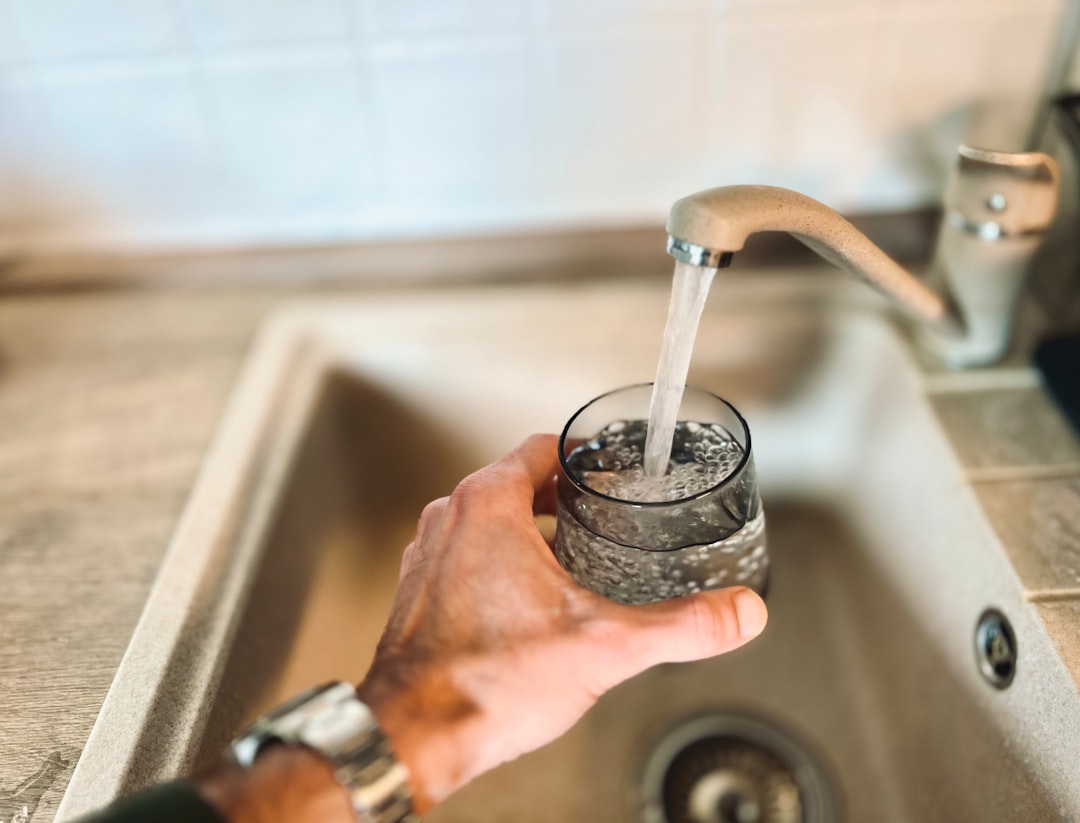New Study Finds PFAS In Drinking Water Everywhere, Here's How To Protect Yourself
Plus, Houston Plans To Spend Millions To Relocate Residents From A Toxic Area

PFAS, or per- and polyfluorinated alkyl substances, are the contaminants of concern right now. The “it” girls of toxins, if you will.
These industry byproducts are manmade chemicals, found in everything from firefighting foams and stain-resistant sprays to nonstick cookware and water-resistant fabrics, and they have no business in our water supply. Not surprisingly, the highest levels are found near facilities that made or used these substances, but they have made their way far beyond the factories.
A new study by the U.S. Geological Survey found them in at least 45 percent of U.S. tap water. More than 12,000 types of PFAS exist, not all of which can be detected with current tests; the USGS study tested for the presence of 32 types and found our nation’s water to have one or more types of the chemicals.
USGS sampled water from 716 locations, including 269 private wells and 447 public supply sites, marking the first time anyone has tested for and compared PFAS in tap water from both private and government-regulated public water supplies on a broad scale throughout the country.
“USGS scientists tested water collected directly from people’s kitchen sinks across the nation, providing the most comprehensive study to date on PFAS in tap water from both private wells and public supplies,” said USGS research hydrologist Kelly Smalling, the study’s lead author. “The study estimates that at least one type of PFAS, of those that were monitored, could be present in nearly half of the tap water in the U.S. Furthermore, PFAS concentrations were similar between public supplies and private wells.”
You can learn more about USGS research on PFAS by reading the USGS strategy for the study of PFAS and visiting the PFAS Integrated Science Team’s website.
Scientists have already found PFOA and PFOS (two types of PFAS) in the blood of nearly all the people they tested in the U.S. Researchers at Johns Hopkins University’s Bloomberg School of Public Health also found that newborn babies are exposed to both PFOA and PFOS in the womb.
Even low doses of PFAS in drinking water have been linked to suppression of the immune system, including reduced vaccine efficacy, and an increased risk of certain cancers. PFAS are linked with increased cholesterol, reproductive and developmental problems and other health harms. Finding PFAS in your water means you could be exposed to these risks.
The U.S. EPA is poised to release new data this month too. It’s the first round of data from a rule that requires many water systems to test for the presence of 29 PFAS that are not regulated under the federal drinking water law, including some that would be regulated by proposed EPA regulations.
The data is required under what’s known as the Fifth Unregulated Contaminant Monitoring Rule, or UCMR 5. The Safe Drinking Water Act (SDWA) requires that once every five years, EPA issue a list of unregulated contaminants that must be monitored by public water systems (PWSs).
All PWSs that serve communities of 3,300 or more people and 800 representative systems serving fewer than 3,300 people must monitor for specific contaminants in their water. UCMR 5 listed the more than two dozen PFAS that these public water systems must monitor, including PFOA and PFOS.
Results of that monitoring data are set to be released in the next three years, with the first round of data coming in July. It’s expected to show thousands of new locations across the U.S. confirmed to have PFAS in their water, affecting millions more Americans than previously known.
But those of us watching the PFAS crisis unfold have suspected for years that the more we test, the more PFAS we will find.
This new EPA dataset is likely to support the estimate published by Environmental Working Group scientists in 2020 that more than 200 million Americans could have PFAS in their drinking water.
So hold onto your hats! PFAS is probably coming to a tap near you. Actually, it’s probably already been there, but now the regulatory agency that is supposed to protect you from toxins in your water is finally doing its job. I hope.
Yikes!
The EPA is now taking the first steps in the agency’s history to tackle PFAS pollution.
ICYMIS: After years with no enforceable national drinking water limits for PFAS, the EPA in March proposed maximum contaminant levels, or MCLs, that restrict the amount of six individual PFAS that can be in drinking water: PFOA, PFOS, GenX, PFBS, PFNA, and PFHxS.
If finalized, this standard would be the first new MCL for drinking water contaminants issued by the EPA in more than two decades. Double yikes!
The proposed MCLs are 4 parts per trillion (ppt) for PFOA and PFOS. For the other four PFAS chemicals, the EPA is proposing a “hazard index,” which is a tool the agency uses to address cumulative risks from mixtures of chemicals.
We already know that when MCLs get lowered or even enforced, it puts a lot of drinking water systems into an immediate crisis.
How can you protect yourself? Get a water filter!
This is not an ad. I have endorsed various water filters throughout the years, but if you are specifically worried about PFAS, you need to get a filter that can handle these chemicals.
You need a water filter that can remove forever chemicals from your tap water.
Our friends at EWG have released a guide to the best water filters for eliminating PFAS, with options for all budgets and sizes. They measured how much each water filter was able to reduce PFAS, considering important factors such as the product’s cost and useful life.
EWG staff tried 10 different water filters in real homes using their tap water, and their guide covers how easy the products are to use and how long they last.
Four water filters reduced the PFAS in the water used in their testing by 100 percent or came close, offering a great boost to your efforts to protect your family’s health. They include: a travel Berkey, Zero Water, Clearly Filtered, and Epic Water Filter.
To get all the details and links, check out their Guide To Water Filters.

Meanwhile, in Houston, it’s a story we know all too well. Residents who are sick and dying come to discover something toxic in their drinking water.
The Union Pacific Railroad Houston Wood Preserving Works site (UPRR) is located adjacent to the Kashmere Gardens community within the Fifth Ward in the City of Houston. Formerly owned and operated by Southern Pacific Railroad, the site ceased operating as a wood preserving facility in 1984, according to the EPA.
For decades, residents have suspected pollution in the area may have caused an unusually high number of cancer cases among their friends, family members, and neighbors.
When the city’s health department finally tested in 2022, they found dioxins in soil samples along the fence line of a Union Pacific rail yard.
Creosote, a mix of chemicals used as a wood preservative, and a probable carcinogen was used for more than 80 years at the site until the 1980s. Creosote operations ceased before Union Pacific took over the facility in 1997, but a toxic plume of contamination remains underground.
City officials say the contamination has reached the groundwater in the area.
Houston Mayor Sylvester Turner said during the 2022 Texas Tribune Festival that plans to clean up the contamination should include relocating residents, and last week he announced plans to move forward with that promise.
In a July 13 press conference, he was joined by the Houston Health Department to announce that city officials are planning to spend millions to help relocate residents from this toxic neighborhood.
In 2019, Texas health officials identified a cancer cluster in the areas, and a second cluster was identified in 2021. They found higher rates of respiratory cancers as well as childhood cancers, including acute lymphoblastic leukemia.
Union Pacific “has an open invitation to help fund this (relocation) effort and to participate in this process, if they so choose. But they not only have a legal obligation, they have a moral obligation. How many more families do you need to see suffer? How many more children must die before they have a moral obligation to step in?” Turner said during the news conference.
In a statement, Union Pacific said additional testing is “required to accurately determine the true extent and source of contamination in the neighborhood. Relocation should be based on a human health risk assessment.”
You can’t see it, but I’m shaking my head from that statement.
The mayor said relocating families from among the 100 properties that have been affected by the contamination could cost up to $26 million. Where will the money come from? He said the city is looking at both internal funding sources, as well as federal funding.
No timetable was offered for when the relocated residents will be in new homes, but Turner said the relocation effort will extend beyond his administration as his final term concludes at the end of December.
Add your voice to the conversation! Do you have a filter that is specific to PFAS? Do you think cities should relocate folks near polluted sites? Let’t talk about it in the comments below.



I've been using the Berkey water filter for nineteen years. After reading the EWG report that you reference in your article, I am glad that I purchased it.
For every pound of adipose tissue (fat) the body has to make a mile or more of blood work “carrying chemicals”. Lose weight, fast…12-18 hrs to help the body detox helps, give the body support and it will help you. Exercise, sweat is the third kidney! We must learn to take personal responsibility as much as we are able too.